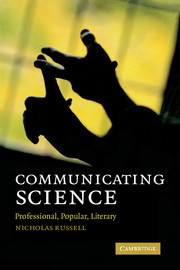Book contents
- Frontmatter
- Contents
- Introduction: What this book is about and why you might want to read it
- Prologue: Three orphans share a common paternity: professional science communication, popular journalism and literary fiction are not as separate as they seem
- Part I Professional science communication
- Part II Science for the public: what science do people need and how might they get it?
- Part III Popular science communication: the press and broadcasting
- Part IV The origins of science in cultural context: five historic dramas
- Part V Science in literature
- Index
Introduction: What this book is about and why you might want to read it
Published online by Cambridge University Press: 02 December 2010
- Frontmatter
- Contents
- Introduction: What this book is about and why you might want to read it
- Prologue: Three orphans share a common paternity: professional science communication, popular journalism and literary fiction are not as separate as they seem
- Part I Professional science communication
- Part II Science for the public: what science do people need and how might they get it?
- Part III Popular science communication: the press and broadcasting
- Part IV The origins of science in cultural context: five historic dramas
- Part V Science in literature
- Index
Summary
This is a book about the benefits and problems of communicating science, not a book about how to actually communicate. There are many useful things to say about practising science communication: writing, speaking, presenting, being interviewed, building websites, making podcasts and so on, and they are all well said in a variety of other places. This book has a different purpose.
Rather than assuming that the main problem in communicating science is that many scientists are not good at it (because they have no training or are not interested) it suggests that there are other questions to ask. Some of these are obvious; why communicate science in the first place, what science should be communicated, to whom should it be addressed and whose interests are served? Such questions are central to the analysis of any communication process and the answers (in science as elsewhere) are complicated.
It is not only the factual communication of science that is important. Fiction and other entertainment media create and reflect social attitudes towards science and scientists, so it is valuable to look at how science is presented in novels, short stories, feature films, plays, comics, graphic novels, computer games, social networking sites and so on. The range of such cultural artefacts is large and in this book there will only be space to cover fiction and drama.
- Type
- Chapter
- Information
- Communicating ScienceProfessional, Popular, Literary, pp. xi - xivPublisher: Cambridge University PressPrint publication year: 2009



